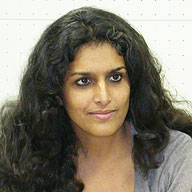An Interview with Vani Subramanian
Someone Is Going through Hell for Your Convenient Life

Q: It seems unique that you chose to approach the social issue of slum removal. Why did you decide to focus on the urban policy aspect of the issue?
VS: In terms of this issue, we’ve been living it. There are two or three elements of urban policy that have caused displacement of the poor over the past five years. There has been a Supreme Court ruling in response to public interest litigation on industrial waste, so the polluting industries have been closed. But all that happened was plant closings, and what about the workers? That is one big cause of displacement in New Delhi. The other thing is the master plan for regulating development. There are a lot of changes in the master plan, and many poor people have been ruled to be encroachers violating the master plan, and are being displaced from where they live. Third, the city runs on day labor, but we have no way of working that into our vision of the city. There’s the idea that the city will be economically independent, perfect for tourists, perfect for multinationals to come in and invest—a perfect global city, where we don’t have to deal with the ugliness of the poor and the working class. But the city runs on day laborers. And that is the tragedy of it. A person in my mentality doesn’t know that the day laborer has been displaced, and now has to commute thirty kilometers to get to work.
Q: The films from India at the festival all grapple with difficult social issues, and do you see this social consciousness as a strong tradition in India?
VS: It is ironic, but in the past documentaries really used to mean government propaganda in India, and newsreels were screened before ever feature film played in theaters. So you have a large population that is very resentful of documentaries and newsreels. Equally, therefore, documentary films are viewed as a voice of expose, and it is very much the agenda that you need to make campaign material for movements and struggles. It is only in recent years that people have started taking liberties, and feel like they can do something irreverent—for example, several years ago, I might not have taken the liberties with the form that I did in this documentary.
Q: Was it an obvious choice for you to use English for this work?
VS: The man whose story this was based on came to me and asked me to write a letter. We had worked in the same office eight years ago. He wanted to write it in English, even though it isn’t his language. If you look at the grammar, it is slightly vernacular, and a very Indian kind of usage of English. And I say this with respect. It’s for a literate audience, and I don’t have an issue with that. The visual language itself is very urban. It’s more immediate to an urban kind of language.
Q: How did you arrive at the narrative structure of showing a letter being written on a computer screen?
VS: Writing the letter with that man kind of sparked off something. I was looking for a new language, because you see a huge level of indifference to what is happening in Delhi. How can we create a little crack into that? I didn’t want to get into a huge analysis. And I didn’t want to take a tragic story where someone died because I wanted it to be believable, although it sounds strange. I wanted it to be a generic story, to then create the reality of that generic story. And I didn’t want to create one villain, because there are several forces that came into play at the same time.
Q: You said your film is targeted toward the educated class, and most people who haven’t seen your film probably view development as a very positive thing. Is it mainly an issue of information and education about what is going on?
VS: I’m not saying all development in Delhi is bad. A city needs to accommodate its upper class. You need to do this. But you need to understand that someone is going through hell for your convenient life. It is easy to feel sympathetic for problems that are far away, but people don’t want to acknowledge the problem at their doorstep. And I’m entering into that comfort zone. I’m trying to open a little crack, and to create the possibility for dialogue.
(Compiled by Ann Yamamoto)
Interviewers: Ann Yamamoto, Iyobe Kiwa
Photography: Sato Akari / Video: Matsumoto Miho / 2003-10-14
